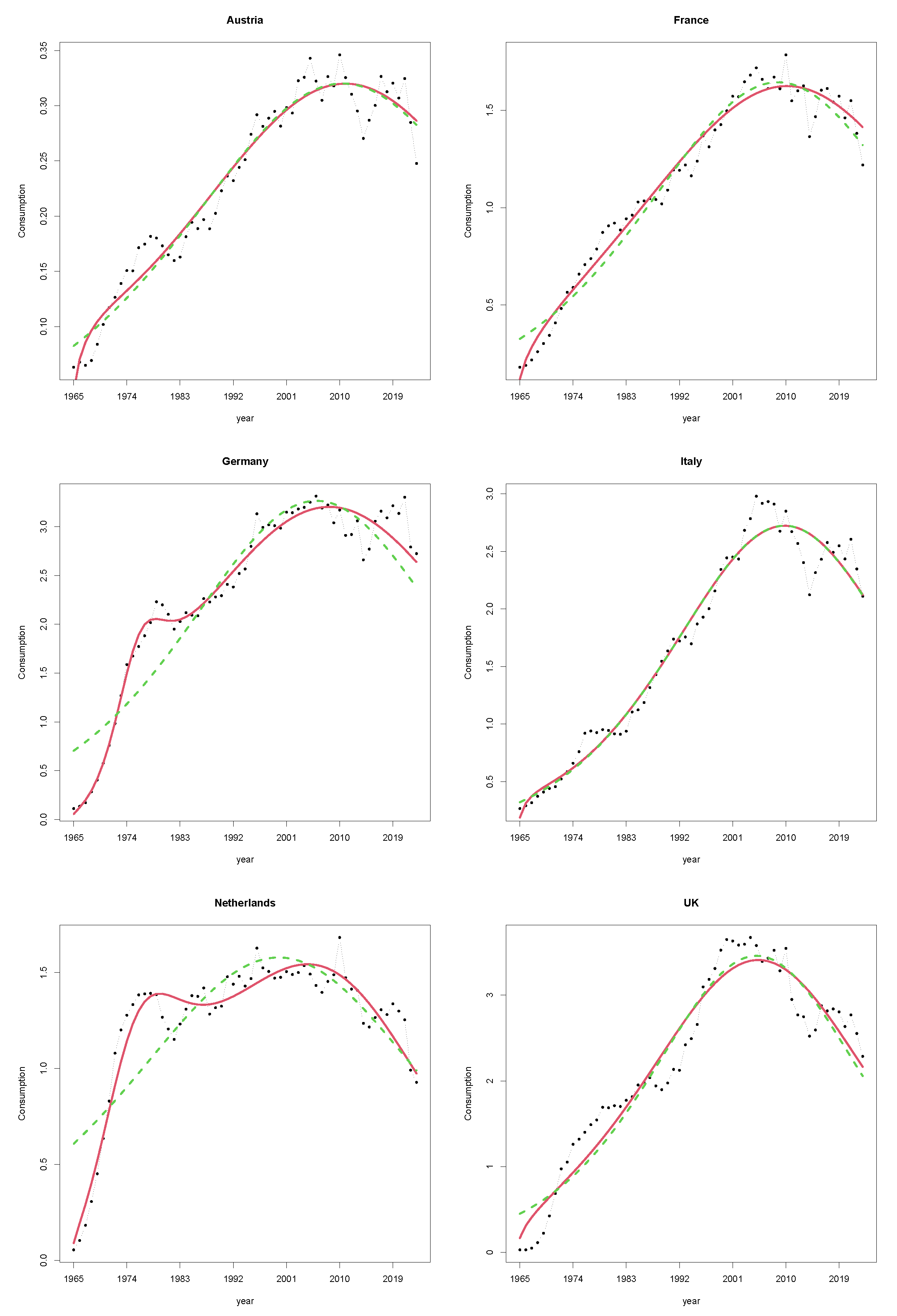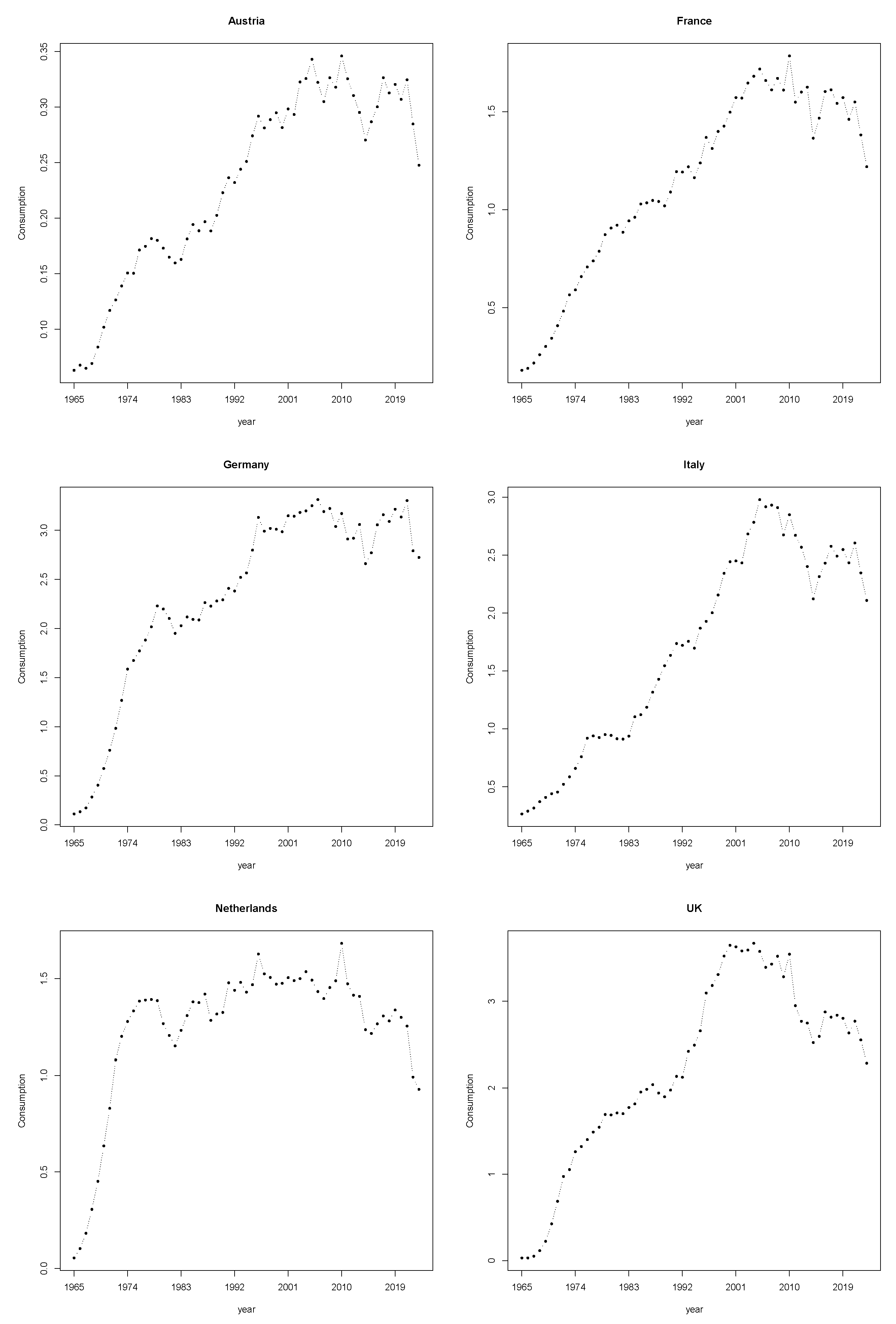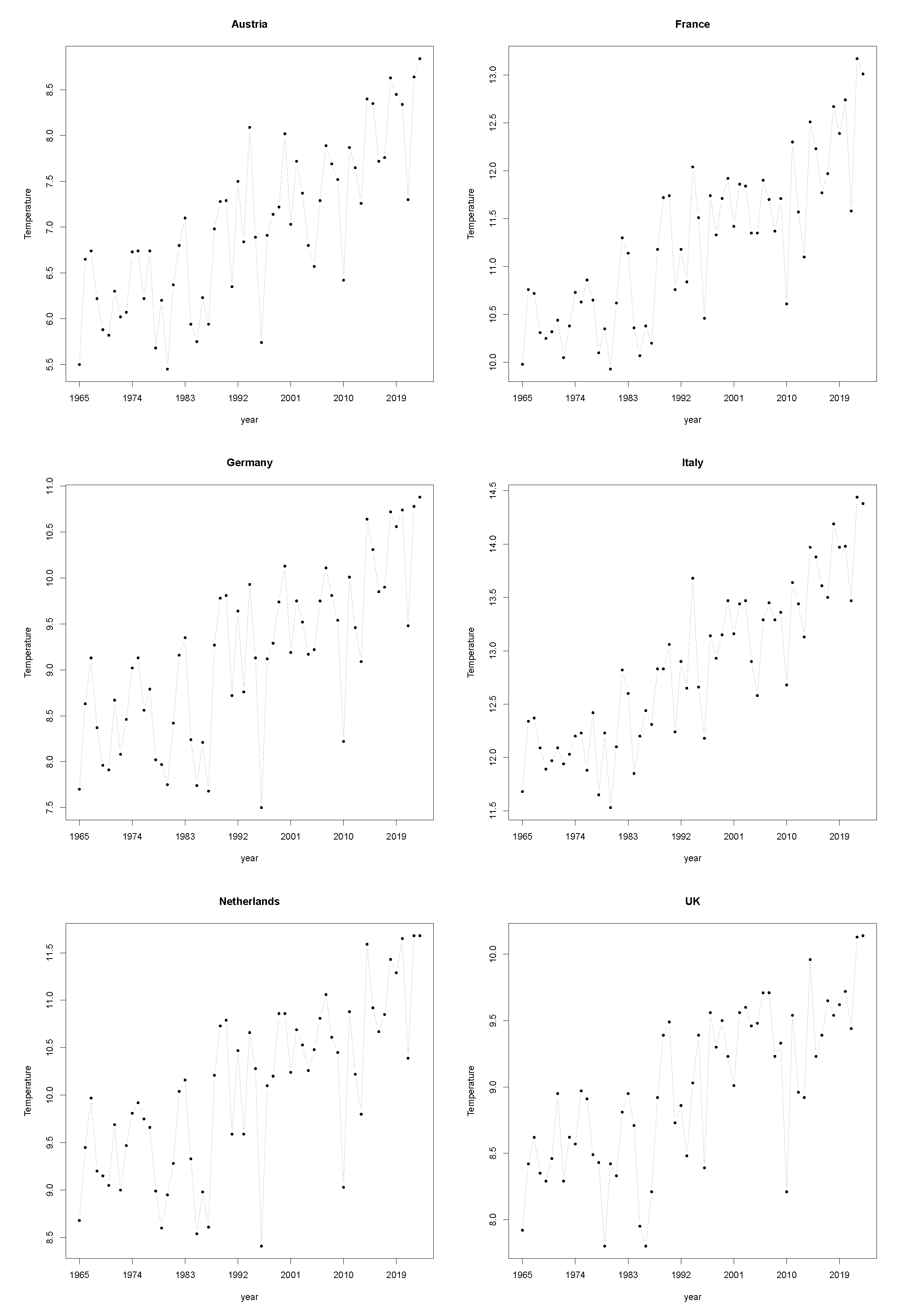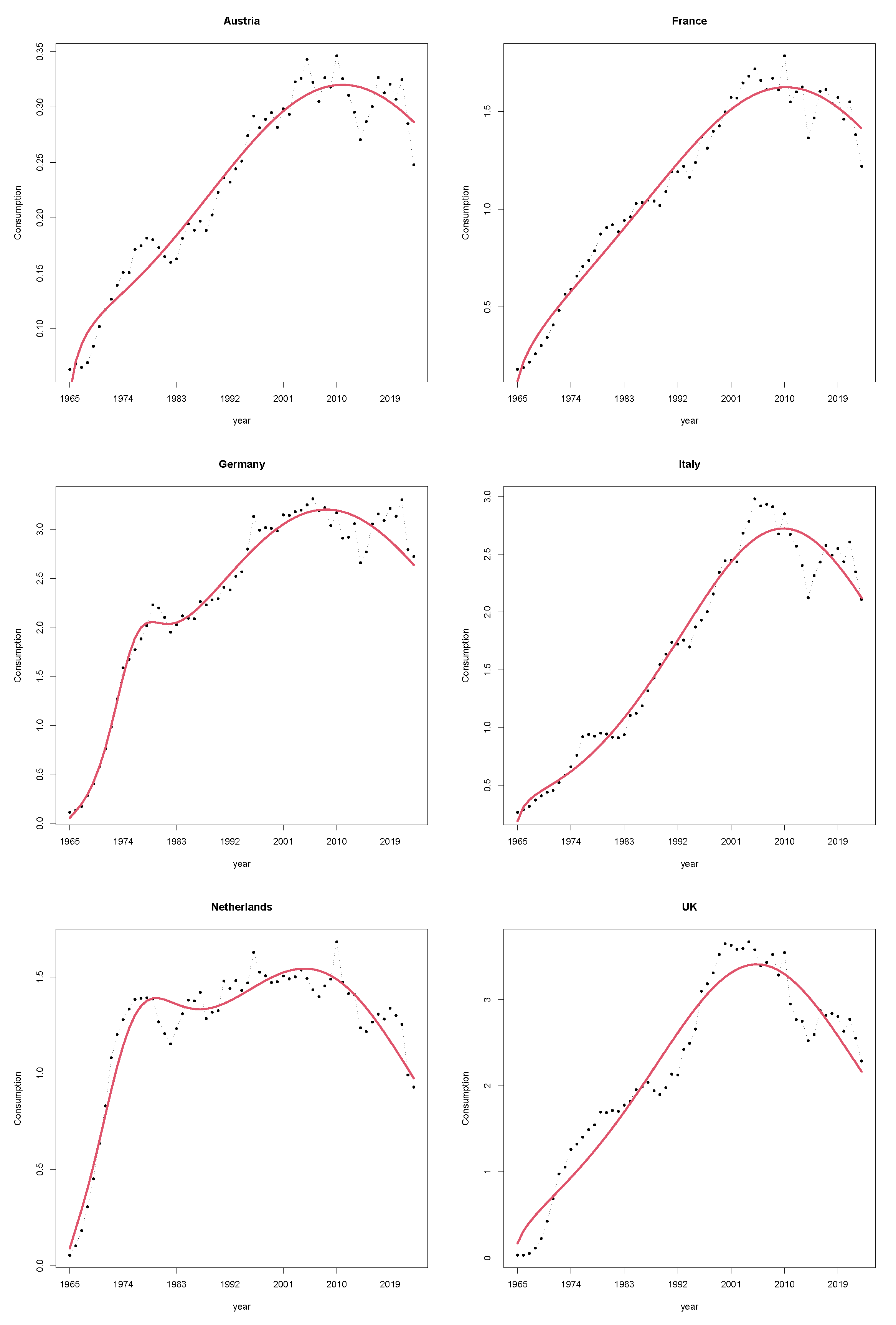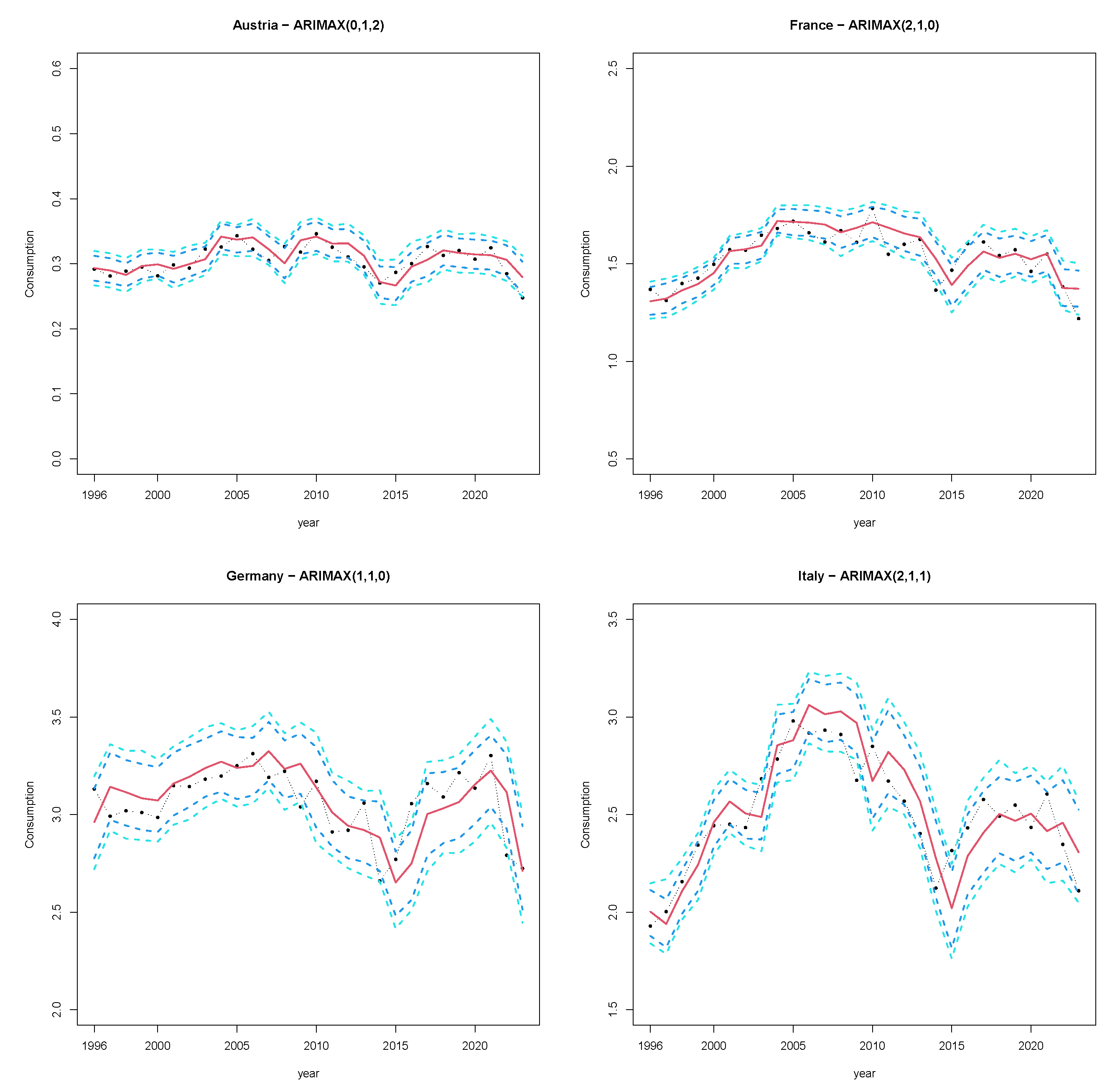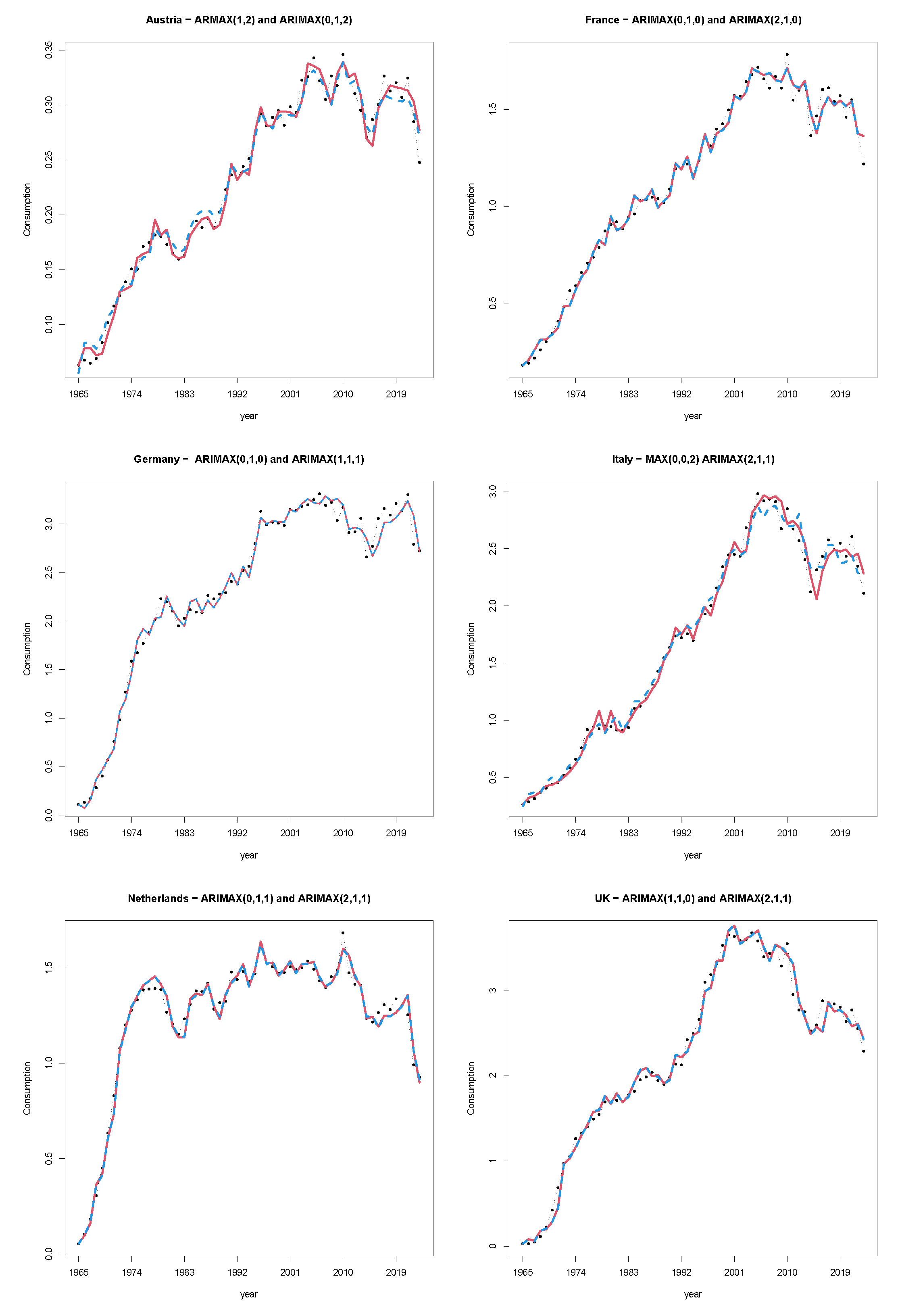1. Introduction
Natural gas consumption in Europe has undergone significant changes in recent years, driven by geopolitical tensions, economic factors, and the continent’s transition toward cleaner energy. Traditionally reliant on imports from Russia, European countries have diversified their energy sources following the 2022 invasion of Ukraine, leading to a sharp decline in Russian pipeline gas and a surge in liquefied natural gas imports from the U.S., Qatar, and others. Total gas demand dropped in 2022 and 2023 due to high prices, energy conservation efforts, and a shift towards renewables (see, e.g., [
1]). The decline was especially notable in industrial sectors, which reduced production or switched fuels. Despite this, natural gas remains an important part of Europe’s energy mix as the region gradually transitions to a more sustainable and energy-secure future, particularly for heating and backup power generation.
According to the International Energy Agency Gas Market Report 2025, natural gas demand is becoming more sensitive to changes in weather patterns, including cold snaps and heat waves. Climate change is driving more extreme weather events; at the same time gas-based generation plays an increasingly important backup role in markets with a growing share of variable renewables, where it ensures security of the electricity supply at times when wind and/or solar output is low.
In Europe, slow wind speeds in the first half of November 2024 led to a sharp decline in wind power output year-over-year. Gas-fired power plants played a key role in providing backup to the power system, seeing their output increase by nearly 80% year-over-year. Higher gas demand was primarily met through larger storage withdrawals. Even if it is still uncertain what caused the massive blackout in Spain and Portugal at the end of April 2025, it is hypothesized that a sudden decrease in renewable energy production could have unbalanced the electricity network, where natural gas would have ensured stability.
These events highlight the need for a careful assessment of investment in the assets that enable the secure delivery of gas, including gas storage, as well as the development of mechanisms that allow for greater supply flexibility. In order to inform effective industrial planning and investments, it becomes critically important from a statistical perspective to forecast annual consumption levels for the coming years, with particular attention to quantifying the degree of uncertainty associated with the predictions and accounting for potential developments in key climatic factors such as temperature trends. Similar considerations have been suggested in [
2], Section 1.1 as well as in [
3].
The scientific literature on forecasting natural gas consumption has expanded recently as natural gas becomes an increasingly critical part of the global energy transition as well as for reasons concerning market volatility and environmental sustainability. Forecasting methodologies have evolved significantly over the past several decades, ranging from statistical models to machine learning and deep learning techniques, as highlighted in [
4], for example. As outlined in [
5], the development of forecasting models can be categorized into four stages. Time series models have proven to be the best models for long-term predictions, while artificial intelligence approaches show better results in short- and medium-term forecasting. Recent studies have emphasized the importance of incorporating external variables such as meteorological conditions [
3] along with economic indicators such as GDP and inflation [
6]. When focusing on short-term time horizons, recent approaches based on convolutional network models have been proposed to capture complex seasonal demand patterns by applying multiple seasonal-trend decompositions in order to separate time series into their periodic patterns and residual components; see, e.g., [
7]. On a regional level, hybrid models have been proposed to address nonlinear trends, particularly in the European Union’s short-term monthly demand forecasts [
8]. On the other hand, comprehensive reviews and scenario-based forecasting frameworks highlight the growing necessity of integrating environmental and sustainability factors into long-term demand modeling; see [
9,
10]. In particular, [
10] observed that most long-term gas prediction studies fail to adequately consider environmental aspects; the authors stressed the importance of considering these influencing factors when forecasting gas demand from national and global perspectives.
The evolving landscape of natural gas demand reflects the need for new approaches that can inform strategic energy planning and policy-making in an era of rapid change. Embracing this perspective, we take a long-term perspective in this paper by modeling the annual consumption of natural gas in a selected number of European countries while accounting for the possible effect exerted by the change in temperatures. In particular, our modeling approach builds upon a well-accepted methodology to capture nonlinear trends in annual energy consumption data, then proposes a subsequent forecasting procedure for proper management of the residual variability observed in the data.
The most comprehensive and suitable form of forecasting in this context is probabilistic, relying on the construction of entire predictive distributions for the quantities of interest; see, e.g., [
11,
12,
13]. However, this approach presents several challenges due to the dynamic structure of the forecasting task within a time-dependent framework and the limited availability of data, which renders non- and semi-parametric methods impractical; see, e.g., [
14], Ch. 12.7.
Therefore, an effective solution for probabilistic forecasting of annual consumption levels requires models with a moderate number of parameters as well as sufficient flexibility to account for the variability in temperature patterns and accurately capture the evolving dynamics of gas consumption. In this work, we propose a dynamic forecasting method based on an additive time series model that addresses such desiderata. The latter incorporates a deterministic component based on the Guseo–Guidolin model (GGM) [
15] to capture long-term trends alongside a stochastic innovation term governed by an autoregressive integrated moving average process with explanatory variables (ARIMAX) to describe annual fluctuations. This approach accounts for both mean drifts and potential variance nonstationarity over time of gas consumption levels. In particular, including mean surface air temperature (yearly average) as a covariate allows us to track consumption variations spurred by fluctuations in climate conditions.
Methodologically, our procedure consists of two steps: first, the parameters of the GGM are estimated using the original series of consumption levels and the resulting trend estimate is used to filter the series; second, an ARIMAX model is fitted to the residual component using a Bayesian approach, which is well-suited for estimating the distribution of the (unobservable) innovations through the posterior predictive distribution. Afterwards, a predictive distribution for k-years-ahead gas consumption levels is obtained by shifting this estimate using the GGM projected trend. The proposed methodology is applied to forecast future consumption in six key European countries: Austria, France, Germany, Italy, the Netherlands, and the United Kingdom. We emphasize that our focus is on developing a procedure that reliably captures historical consumption trends across different countries and on using prediction intervals to offer plausible and dependable ranges for future gas consumption.
The rest of this paper is outlined as follows: in
Section 2, we describe the gas consumption data and covariates used to train the forecasting methods across countries; in
Section 3, we discuss the considered statistical models and predictive tools; in
Section 4, we present the results of our analysis, which forecasts a reduction in gas consumption levels in the coming years up to 2028; finally,
Section 5 briefly discusses possible directions for future work.
2. Data
Our statistical analysis aims to predict gas consumption while accounting for temperature, which is known to significantly influence gas demand (e.g., [
16]). Data on gas consumption from 1965 to 2023 were taken from the Energy Institute (see
https://www.energyinst.org/statistical-review, accessed on 18 May 2025) on a yearly time interval. The consumption amounts exclude natural gas converted to liquid fuels but include derivatives of coal and natural gas consumed during gas-to-liquid transformation. Consumption in exajoules for Austria, France, Germany, Italy, and the UK from 1965 to 2023 is plotted in
Figure 1. These countries were selected due to their being the largest consumers of natural gas in Europe (France, Germany, Italy, Netherlands, UK) in order to provide a general overview of the European landscape in terms of gas consumption. In contrast, Austria was selected as an example of a small country in order to test our model’s applicability to less central market contexts.
Following a sustained upward trend, a downward shift emerges across all six of these countries in the second decade of the 2000s. In particular, a strong year-over-year decline is visible in all countries in 2022, when natural gas demand in the European Union fell by 13.2%. This decline was concurrent with an increase in variability, making the prediction of consumption particularly difficult. We consider the observed annual average mean surface air temperature in centigrade degrees an explanatory variable. These data are publicly available from the World Bank through the Climate Change Knowledge Portal (see
https://www.worldbank.org/en/topic/climatechange, accessed on 18 May 2025) and are reported in
Figure 2 for the time window ranging from 1965 to 2023. With rising temperatures, all six countries are deemed vulnerable to climate change; in particular, an increasing risk of heat waves is reported for France and Germany, while an upward trend in extreme temperatures is recorded for Italy. As temperatures rise due to climate change, natural gas usage for heating is anticipated to decline. At the same time, electricity consumption for cooling is projected to increase, as recently highlighted for other geographic areas, e.g., by [
17]. The ultimate goal of this work is to formalize this uptake in rigorous statistical terms using predictive distributions and prediction intervals.
5. Conclusions
Energy consumption is a complex and multifaceted phenomenon that depends on many factors, including economic, social, and demographic variables as well as political and geopolitical aspects. All of these elements determine the strategic choices of countries when defining their energy mix and setting their future agendas. In addition to these factors, climate change and global warming are increasingly influencing both energy demand and energy policies, for instance according to scenarios proposed in the IEA’s World Energy Outlook 2024 (see
https://www.iea.org/reports/world-energy-outlook-2024, accessed on 18 May 2025). In this complex and uncertain context, the forecasting task poses several challenges in terms of accuracy, adaptability, and policy relevance. Energy demand forecasting is essential for ensuring energy security and efficiency and supporting the global transition towards sustainable and low-carbon energy systems. Developing flexible yet parsimonious forecasting methods represents a priority for researchers, governments, companies, and international organizations seeking to manage the vulnerability of today’s energy markets and ensure energy security.
This work shows how combining innovation diffusion models—particularly the GGM—with ARIMAX provides a flexible framework for forecasting future gas consumption. This approach accounts for different temperature evolution scenarios and quantifies forecast uncertainty. As a general remark, we may say that our findings agree with the projected scenarios proposed by the IEA, according to which natural gas consumption is peaking and will decline in the future.
We have decided to focus on the major natural gas consumers in the European Union, considering them as paradigmatic examples of the complexity of energy markets. As reported in the IEA’s World Energy Outlook 2024, the European Union represents 6% of the world’s population and accounts for approximately 10% of global energy demand. The EU continues to be a clean energy leader; energy-related CO2 emissions are declining, driven by increased electricity production from renewables, hydro, and nuclear power recovery, reduced industry emissions, and milder temperatures.
As a first step, we used the GGM to model the mean evolution of gas consumption in all of the selected countries, capturing the declining trend observed across all series. This modeling approach offered a parsimonious and interpretable way to describe the structural dynamics underlying gas consumption, where the observed decline may derive from policy-driven changes such as those promoted by the Fit for 55 package and the REPowerEU plan.
Additional policy initiatives have focused on enhancing the resilience of European gas markets, promoting solidarity, and mitigating extreme price spikes; for example, in July 2022 the EU adopted the European Gas Demand Reduction Plan, which provides best practices and guidance for reducing regional gas demand. These efforts include transitioning from gas use and towards renewables and cleaner energy sources in the industrial, power, and heating sectors.
Thanks to continued policy support for renewables, approximately 50 GW of wind and solar capacity was installed in the EU in 2022, representing a record high; according to the International Energy Agency, these additions offset the need for roughly 11 billion cubic meters of natural gas in the power sector, constituting the single most significant structural driver behind the EU’s recent decline in natural gas demand.
As a second step, ARIMAX modeling allowed us to produce point forecasts for Austria, France, Germany, Italy, the Netherlands, and the UK, suggesting a gradual reduction in consumption between 2024 and 2028. The same downward trend is generally followed by the upper and lower bounds of the produced predictive intervals. This clear-cut trend does not appear to stem from the smoothness of the temperature paths projected in CMIP6, which we adopted as covariates in our analysis, despite observed temperatures prior to 2023 tending to exhibit much more irregular fluctuations.
Indeed, similar conclusions have been reached when statistically modeling temperatures and using simulated paths for future temperatures from inferred models.
To extend the analysis, socioeconomic variables could be taken into account more explicitly by including them as covariates in the model rather than implicitly accounting for them, as in our GGM–ARIMAX framework. At the same time, one of the benefits of our proposed framework lies in its parsimony, which would be threatened by adding other parameters deriving from the inclusion of several covariates. Furthermore, our two-stage methodology can be easily used and implemented on different case studies referring to other countries by using publicly available energy consumption and temperature data. This potential for generalization is ensured by the basic requirements of the proposed approach in terms of both data and modeling complexity.
From a modeling point of view, a further interesting direction for future work is to infer both the GGM and ARIMAX model parameters in a Bayesian fashion, allowing both components to be integrated out with respect to the posterior when computing predictive distributions. This should ensure a more robust form of model averaging as well as the production of predictive intervals that are underpinned by a more comprehensive quantification of uncertainty.
